Swansea City continue to go from strength to strength in 2019 as they maintained their momentum with a convincing 4-1 FA Cup 4th round win against Gillingham. The victory sees the Swans reach the FA Cup 5th round in consecutive seasons for the first time since 1965.
Gillingham manager Steve Lovell returned to his birthplace hoping for more cup success against South Wales opposition having got past Cardiff City in the previous round, but it wasn’t to be. Had they done so, they would have been only the second team in history to eliminate both South Wales sides in the competition since 1975-76.
With Tuesday night’s home Championship match against Birmingham City in Graham Potter’s sights, the Swansea boss made four changes to the starting XI that beat Sheffield United last weekend. Some of those changes were forced due to injuries. Joe Rodon’s broken metatarsal saw Tottenham Hotspur loanee Cameron Carter-Vickers drafted in alongside former Ajax defender Mike van der Hoorn.
Alongside the American was left-back Declan John who replaced Kyle Naughton which meant that Connor Roberts could return to his preferred right-back position. In midfield, Potter kept faith in the Leroy Fer, Matt Grimes and Bersant Celina trio. Courtney Baker-Richardson and Barrie McKay replaced Wayne Routledge (calf) and Nathan Dyer (benched).
After switching from a 4-2-3-1 formation to a 4-3-3 during his side’s win against Sheffield United last Saturday, Potter stuck with a 4-3-3. Celina was dropped back as Potter looked to Barrie McKay to link up with Baker-Richardson as Oli McBurnie also dropped back to link up the play between midfield and attack.
For the Gills, they made three changes. Max Ehmer, Regan Charles-Cook and Tom Eaves replaced Alex Lacey, Callum Reilly and Josh Parker. Gillingham boss Steve Lovell adopted a 3-4-1-2 system with Charles-Cook playing behind the forward duo of Elliot List and Tom Eaves.
Swansea fly out of the blocks
Swansea City manager Graham Potter has established a new and improved blueprint since the turn of the year and so far its record speaks for itself. That blueprint involves attracting the press and playing vertical passes to make use of the space behind it.
Two wide players moving inside to occupy the half spaces as the full-backs ensure width, added with good movement, creates problems. The opposition defence is often stuck between sitting in a compact, narrow shape and looking to shift out and close down the attacking full-backs.
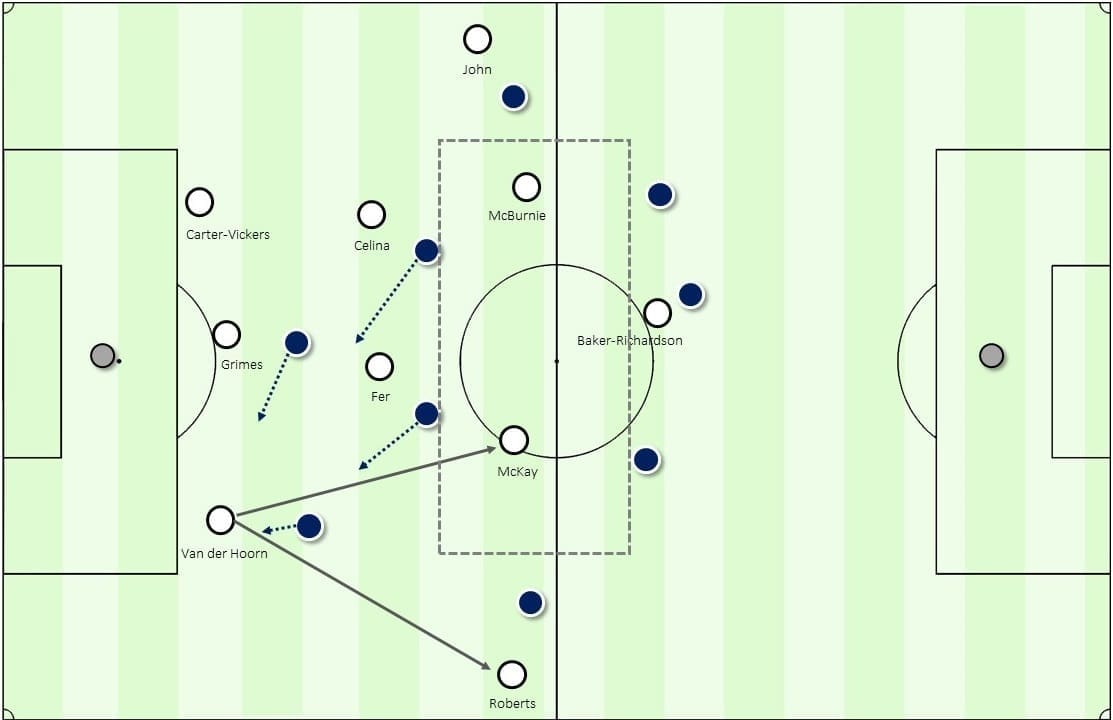
Unbeaten with two league and two FA Cup wins, their direct style and ability to play long vertical passes to break opposition lines has been key to that success. Preston – the only side to avoid defeat against the Swans in 2019 – adopted an effective and well-structured press but the likes of Reading (4-1), Aston Villa (3-0) and now Gillingham (4-1) all suffered heavy defeats as a result of getting their press badly wrong.
Swansea City were often able to play long, vertical passes forward that bypassed Gillingham’s press with ease. This allowed their backline to get the ball quickly into the feet of the attacking players. Receiving in space, they had plenty of time to turn and progress the attacking move forward into the opposition’s half.
Mike van der Hoorn has a good eye for picking out a pass from deep that can break through Gillingham’s lines and get the ball into the likes of Barrie McKay and Oli McBurnie.
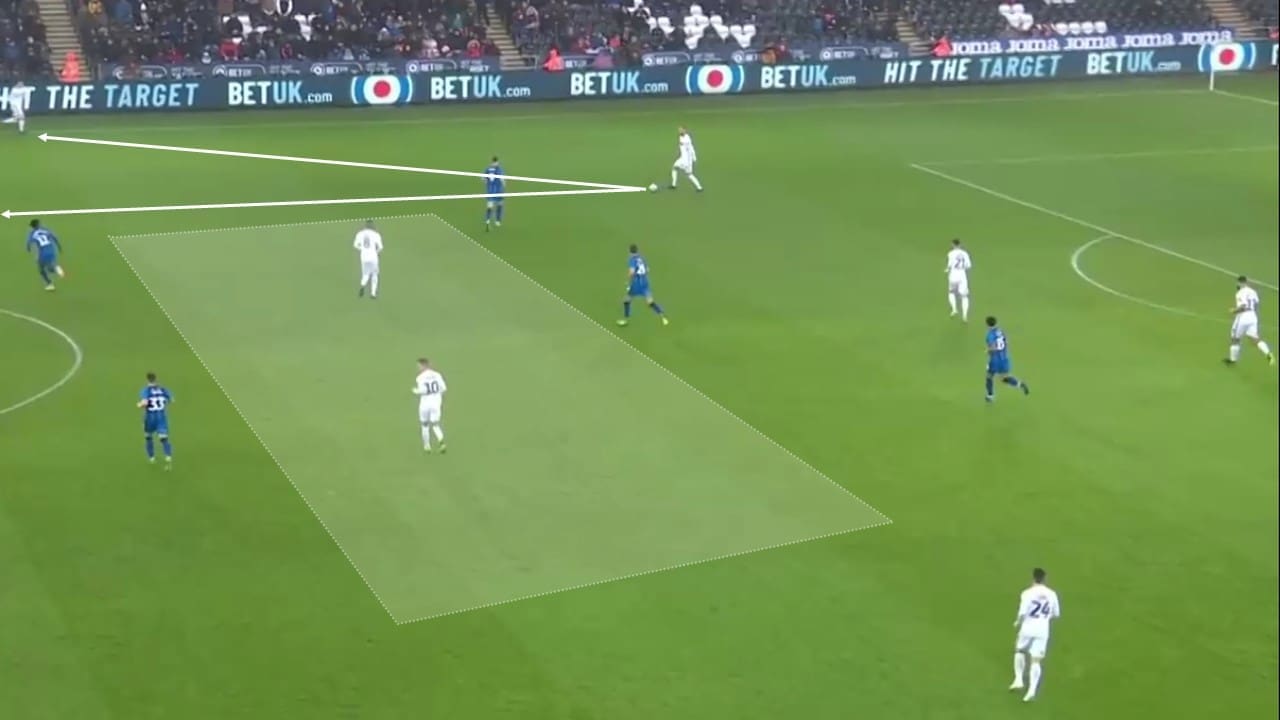
Gillingham’s failed press: Swansea take full advantage
Gillingham’s press was ineffective throughout the game, particularly in the first half. It lacked energy and good structure. Both Grimes and Fer were not closely marked while Bersant Celina also dropped deep into wide open space to receive the ball and start quick attacks from inside his own half.
The obvious problem below for Gillingham is that their front two split. There’s a huge gap between the two. Matt Grimes drops in between the two centre-backs, while Celina can also drop back to receive.
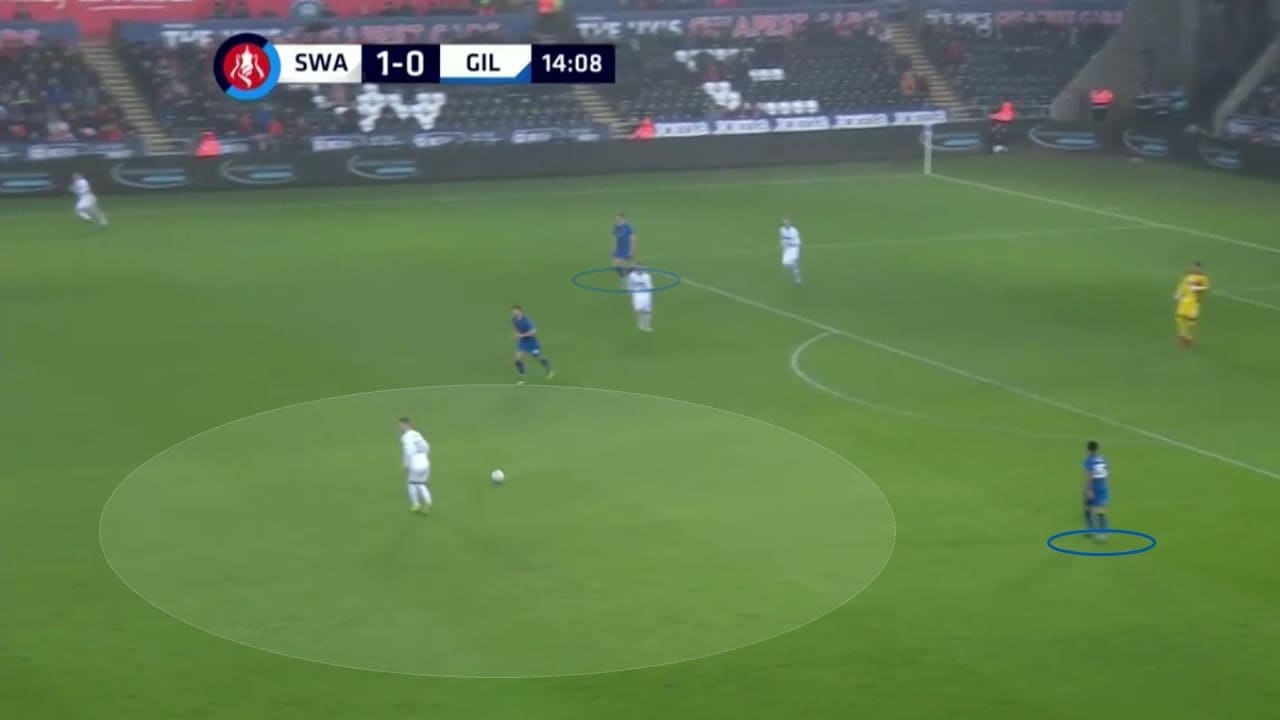
Time and time again the League One outfit left huge gaps right across the field, allowing the Swans to dominate the opening 14 minutes with 80% possession.
Below shows another example of Van der Hoorn’s ease at making a forward pass into the feet of Barrie McKay. McKay took the role of the benched Nathan Dyer as the right-sided attacker who drops deep into these positions to start the second phase of the attack.
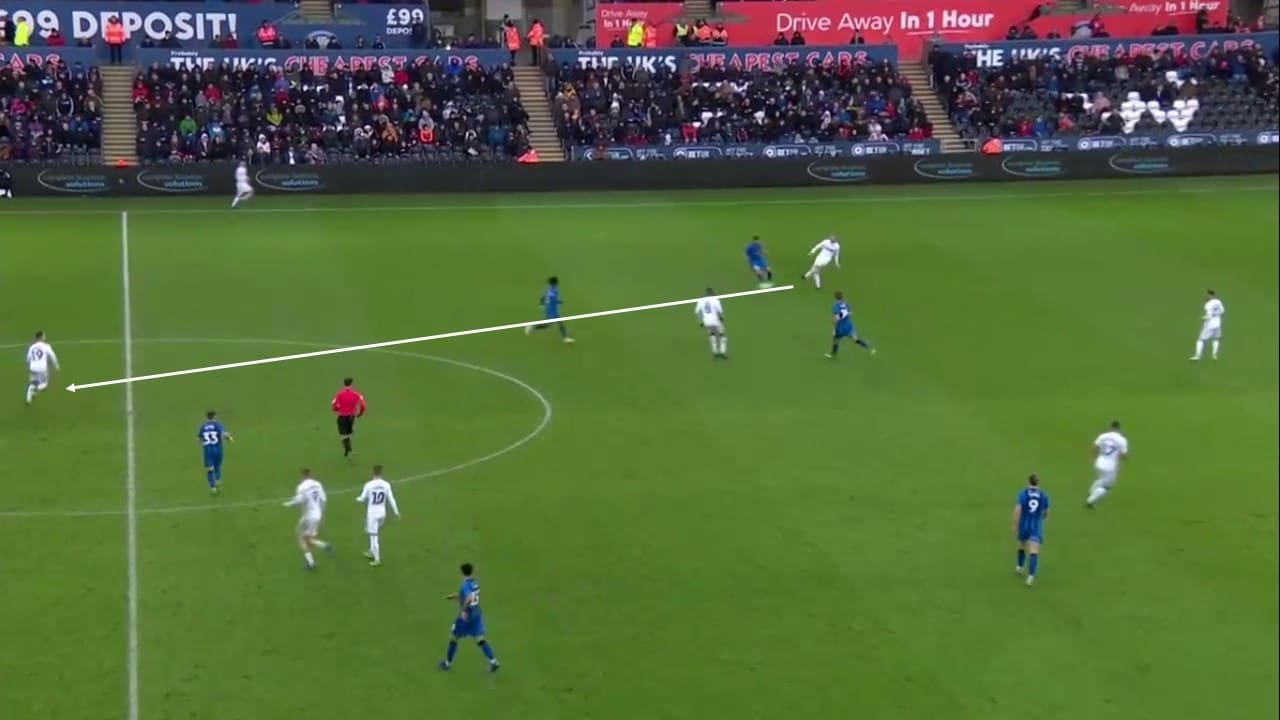
McBurnie, on the left of a front three, dropped deep when needed to help link up the play. The main central striker Courtney Baker-Richardson stayed furthest forward at all times, looking to make runs in behind the last defender.
Swansea City were essentially setup in a 4-3-3 but with good rotations. With the likes of McBurnie and McKay dropping deep, it also morphed into a 4-3-2-1 with the full-backs always bombing forward in an effort to stretch the opposition’s defensive line.
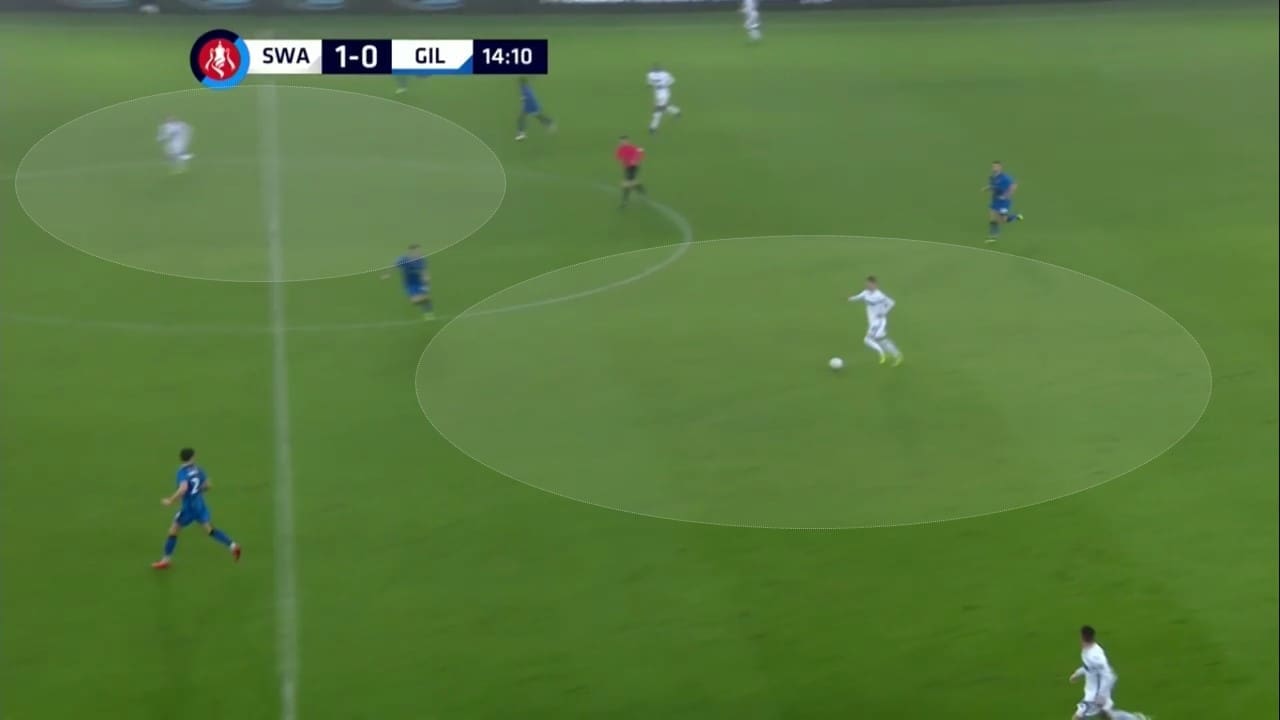
The amount of space Swansea City could work with was no different in their opponent’s half either. At times, these long vertical passes from the defensive line were bypassing four or five Gillingham players and pretty much their entire midfield.
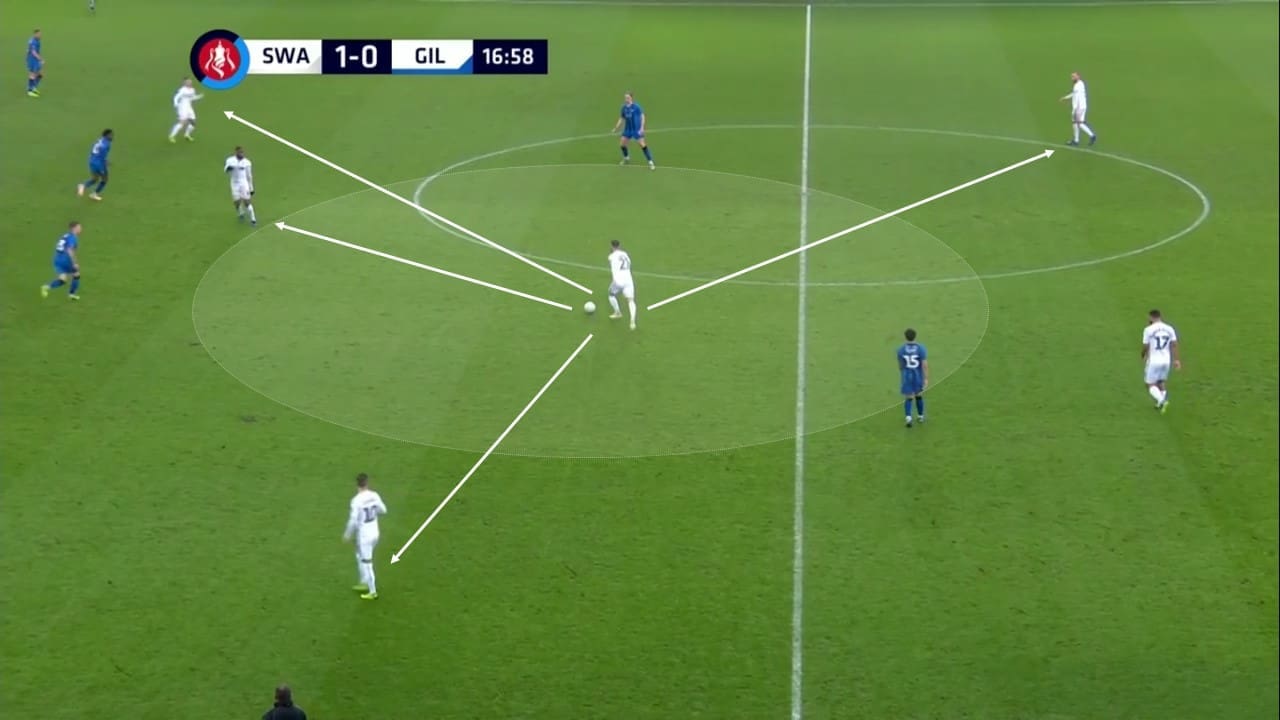
The spaces between Gillingham’s lines were far too large. As we see above, players like McKay, Celina and McBurnie could receive passes in space, turn and run at the opposition’s defence after just a few passes. Midfielders were able to make runs through as Gillingham’s midfielders split wide having been attracted to the two players occupying the half-spaces.
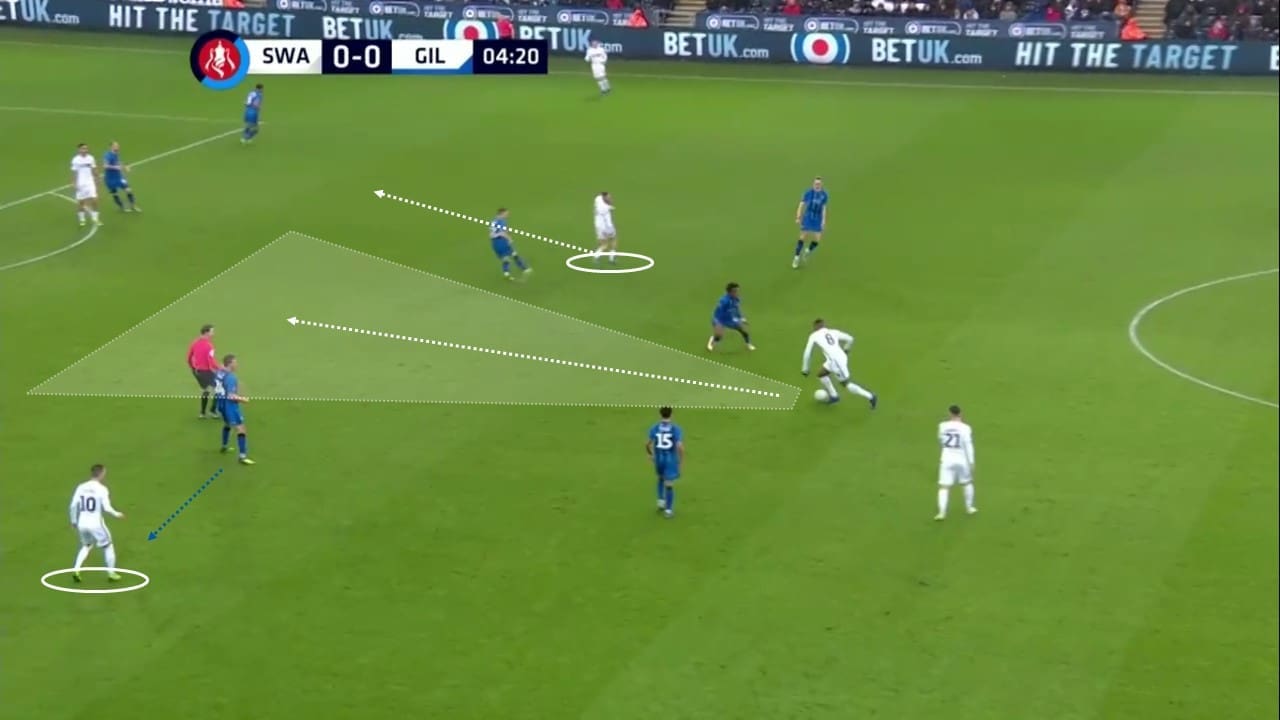
With two Gillingham players keeping tabs on the two Swansea players occupying the half-spaces, this gave Leroy Fer a route through the middle. The screenshot below shows a typical example. Five or possibly six Gillingham players are bypassed with a simple forward pass, Oli McBurnie receives the ball near the halfway line and he’s now able to run forward against the opposition’s defence.
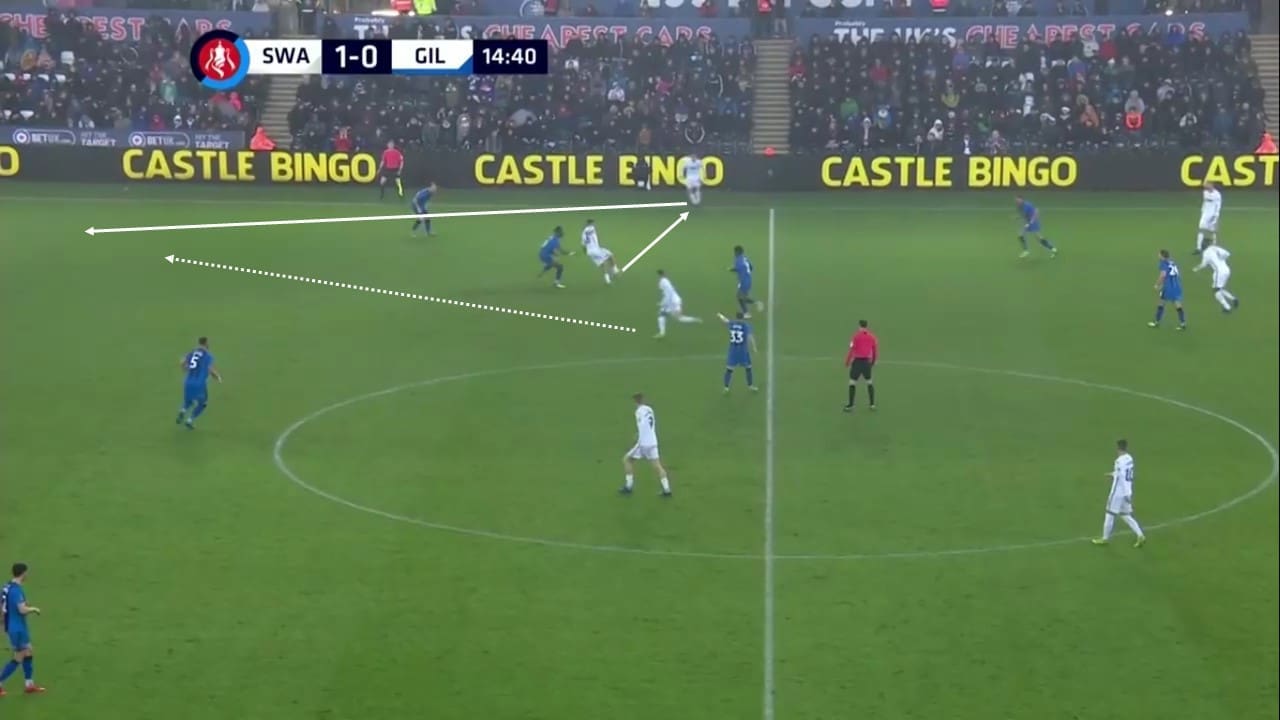
Striker Baker-Richardson moves out into a wide right position in an effort to stretch and expose gaps through the channels.
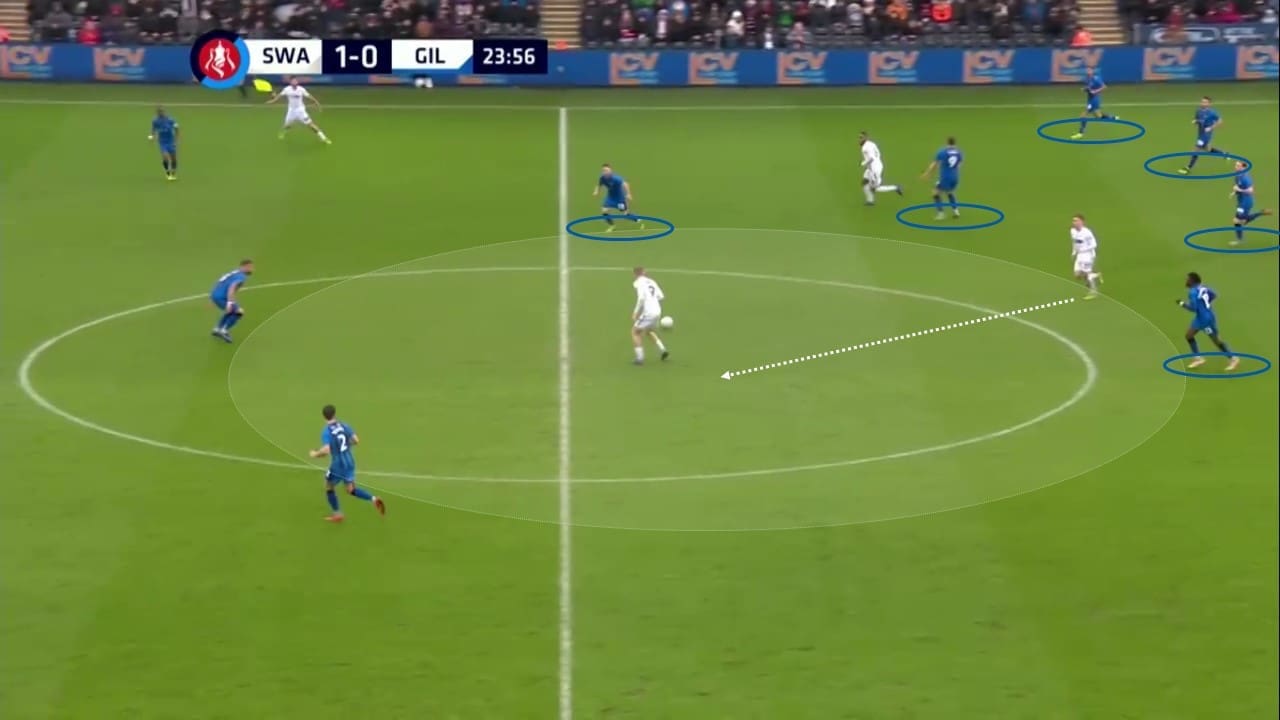
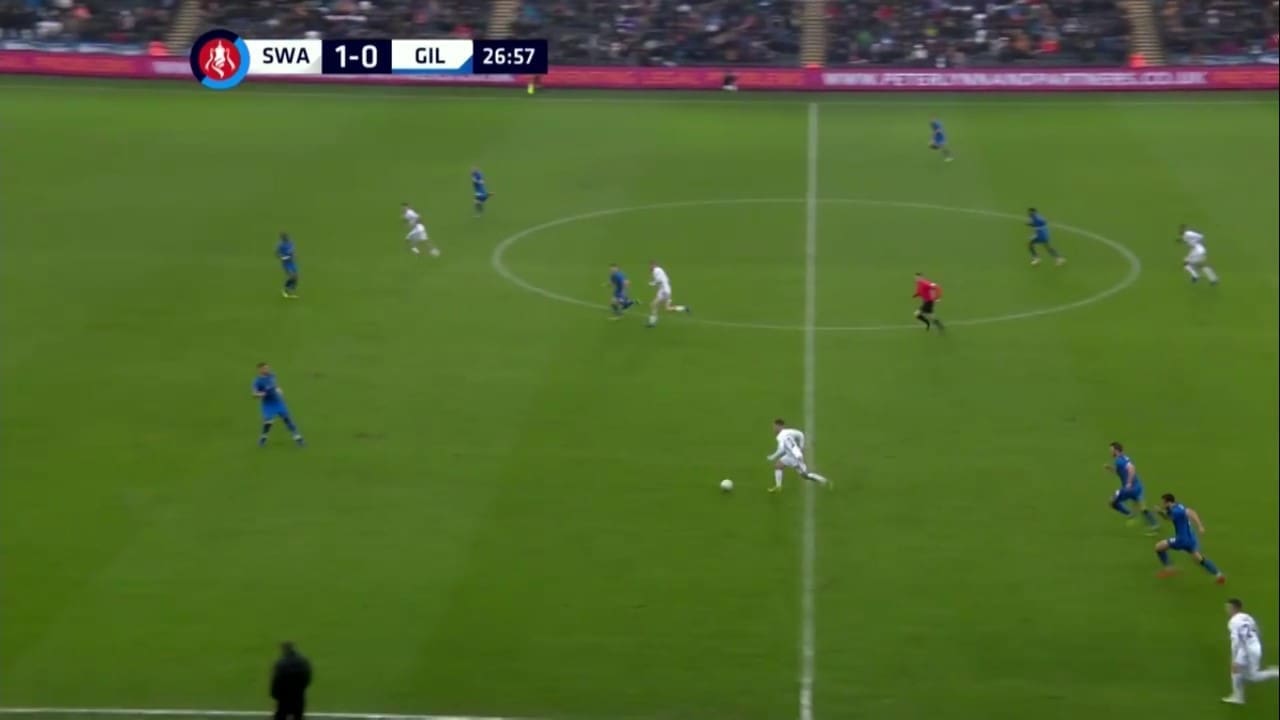
Swansea open the scoring
It was a relentless opening 10 minutes from the home side and they took a deserved lead in the 11th minute. However, it wasn’t a goal that you’d expect from this Swansea side. Goalkeeper Erwin Mulder aimed a long kick for Barrie McKay to chase. A Gillingham defender, unaware of where the ball was, saw the ball come off his back and into the path of the Swansea attacker.
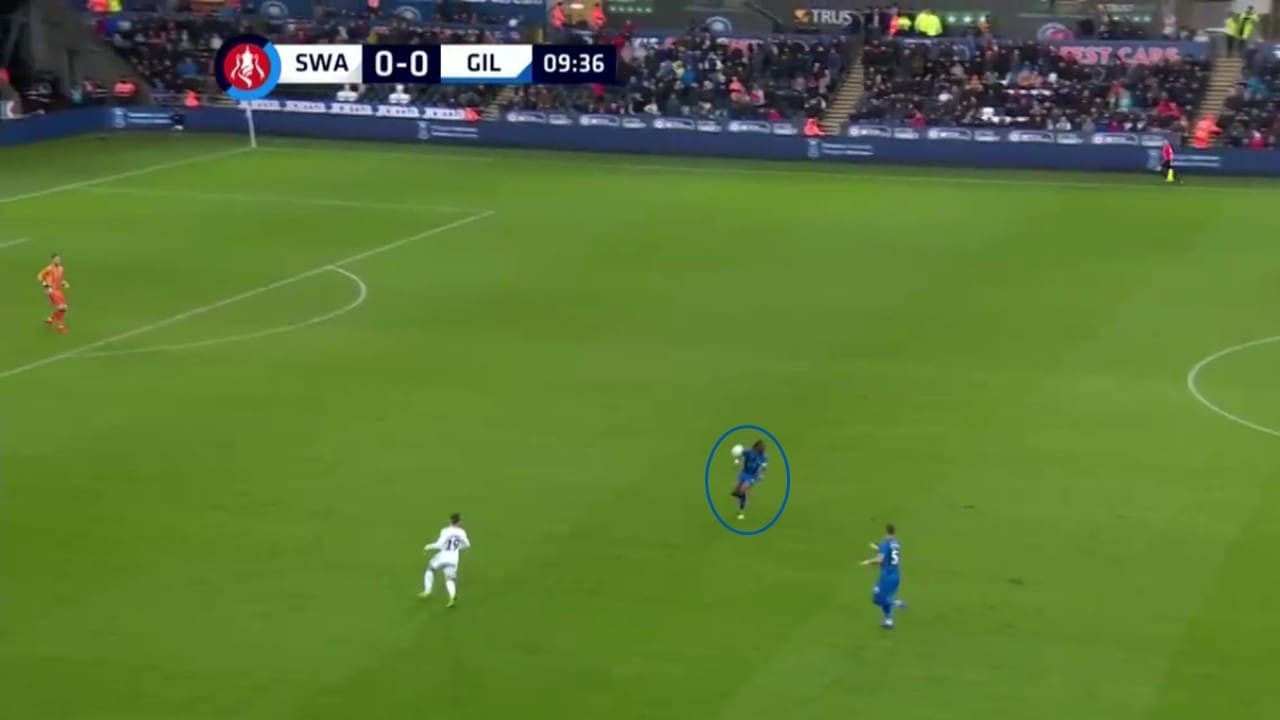
It looked like an opportunity to make use of the space was lost as Barrie McKay had to hold the ball up to wait for support. Bersant Celina is racing forward through the left half space but McKay decides to wait for Leroy Fer to enter the picture.

McKay holds the ball up which allows Gillingham to get players back in support. He has Celina running through as an option but he wants for Fer to move forward. In the other half space, Leroy Fer has time and space to pick out his man.
He crosses in for McBurnie to easily head home as he runs through a gap in the Gillingham defence. Baker-Richardson is tightly marked but the defender next to the one marking him is ball-watching and doesn’t track McBurnie’s run.
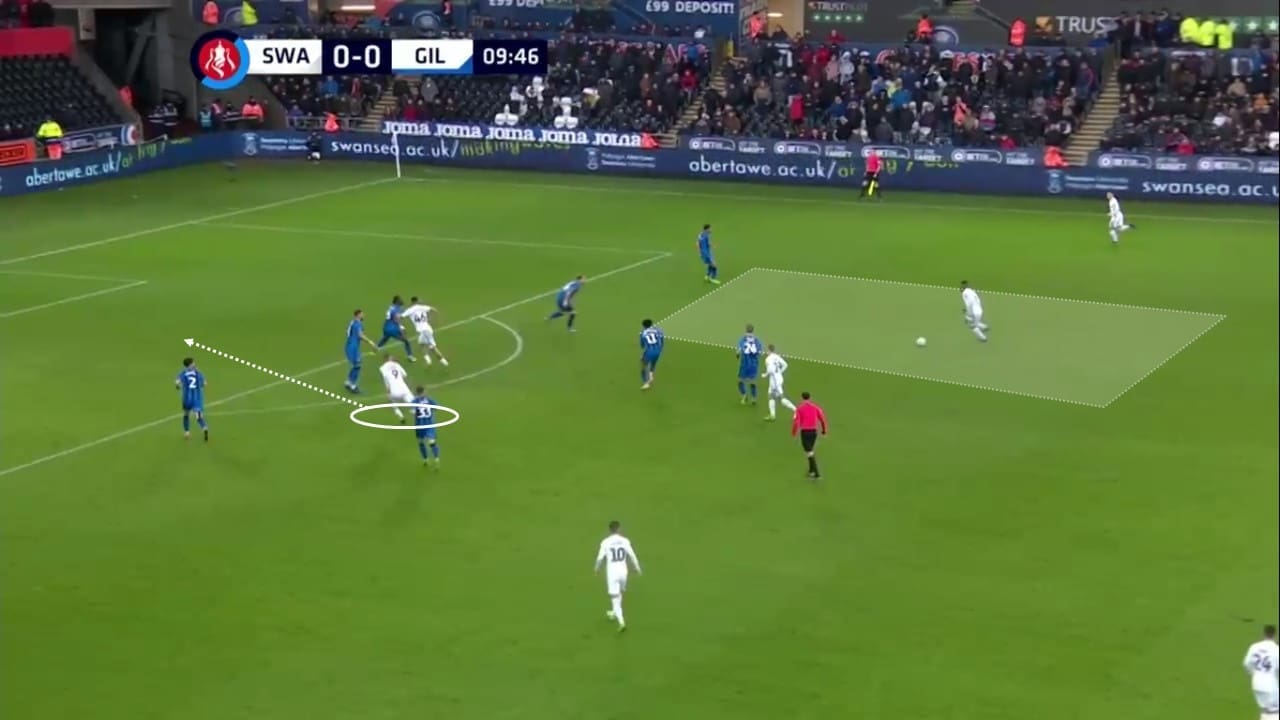
Leroy Fer, unmarked in the right half-space, puts in a cross for McBurnie to run through the middle to head home. The second defender is too busy ball-watching to track the striker’s run.
Swansea City make it 2-0
Gillingham made efforts to tighten things up through the middle third as we can see in the screenshot below. Nevertheless, Matt Grimes was able to switch the play across to right-back Connor Roberts to help start the attacking move for the second goal just after the half-hour mark.
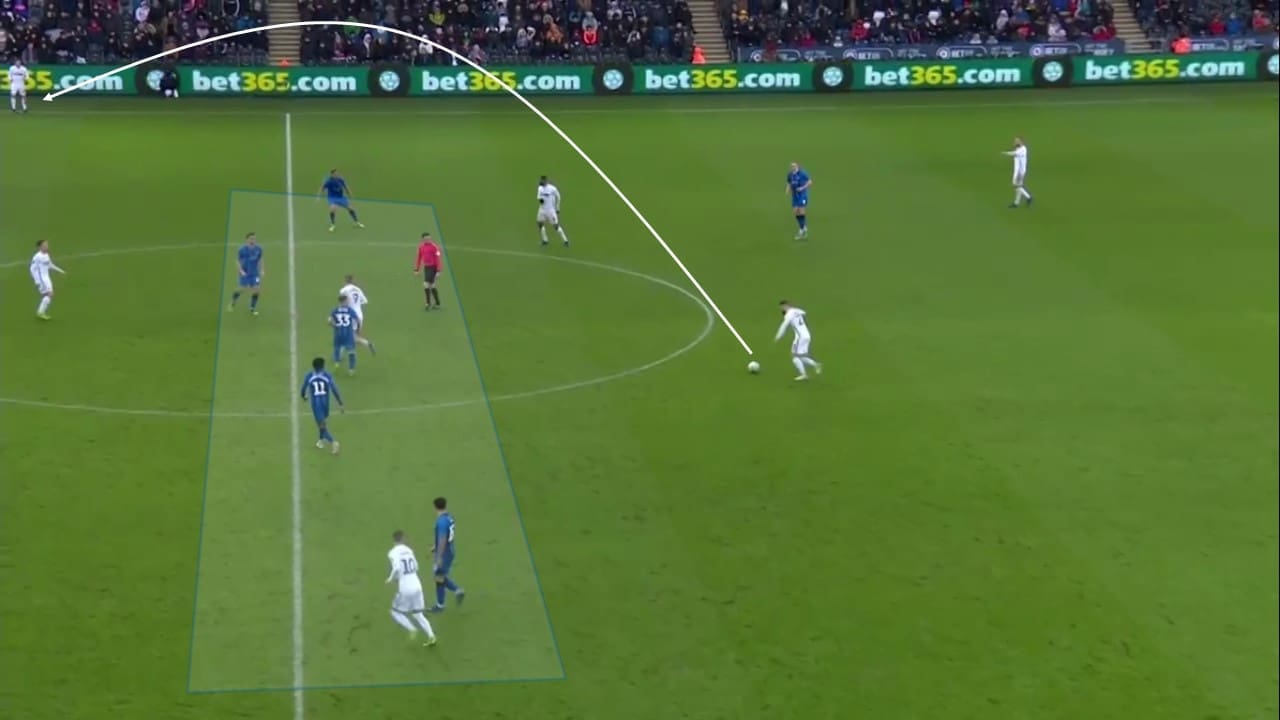
Mckay makes a good diagonal run out to the right flank and takes a defender with him. This opens up the half-space for Oli McBurnie to run straight through as Roberts plays the inside pass to the striker.
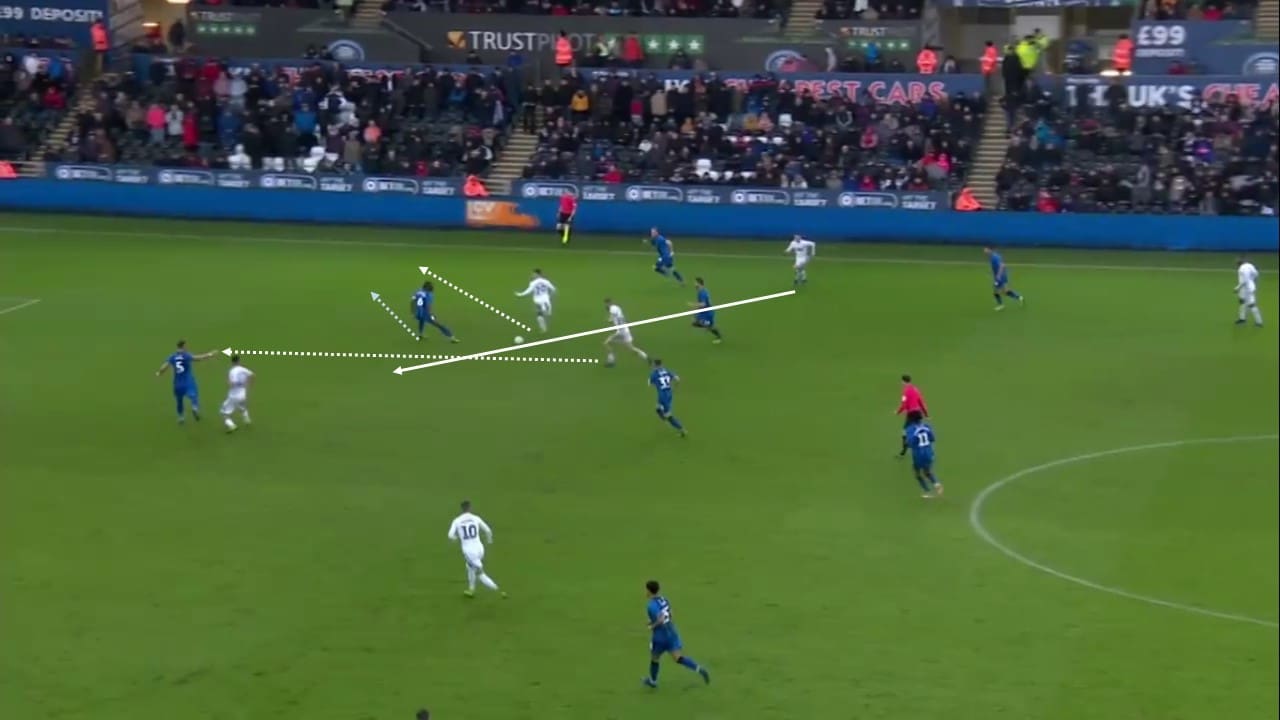
Unchallenged, McBurnie makes it into the penalty area to fire past the goalkeeper for his second of the game.
Gillingham problems and how they looked to fix them
After going 2-0 down within half an hour, the visitors needed to change a number of things if they wanted any chance of staying in the game in the second half. Their press was completely ineffective and Swansea City found it far too easy to play through it. Time and time again they were able to make just two or three passes to approach the final third of the pitch.
If they couldn’t stop passes coming into the middle third from Swansea’s defensive line, then their second best option was to drop deeper and plug the gaps. Below shows another typical example of Gillingham’s ineffective high pressing from their front two.
Matt Grimes drops in between the two centre-backs gave Swansea a numerical advantage from deep. Without a third Gillingham player pushing forward, Matt Grimes or Bersant Celina could bring the ball out with ease.
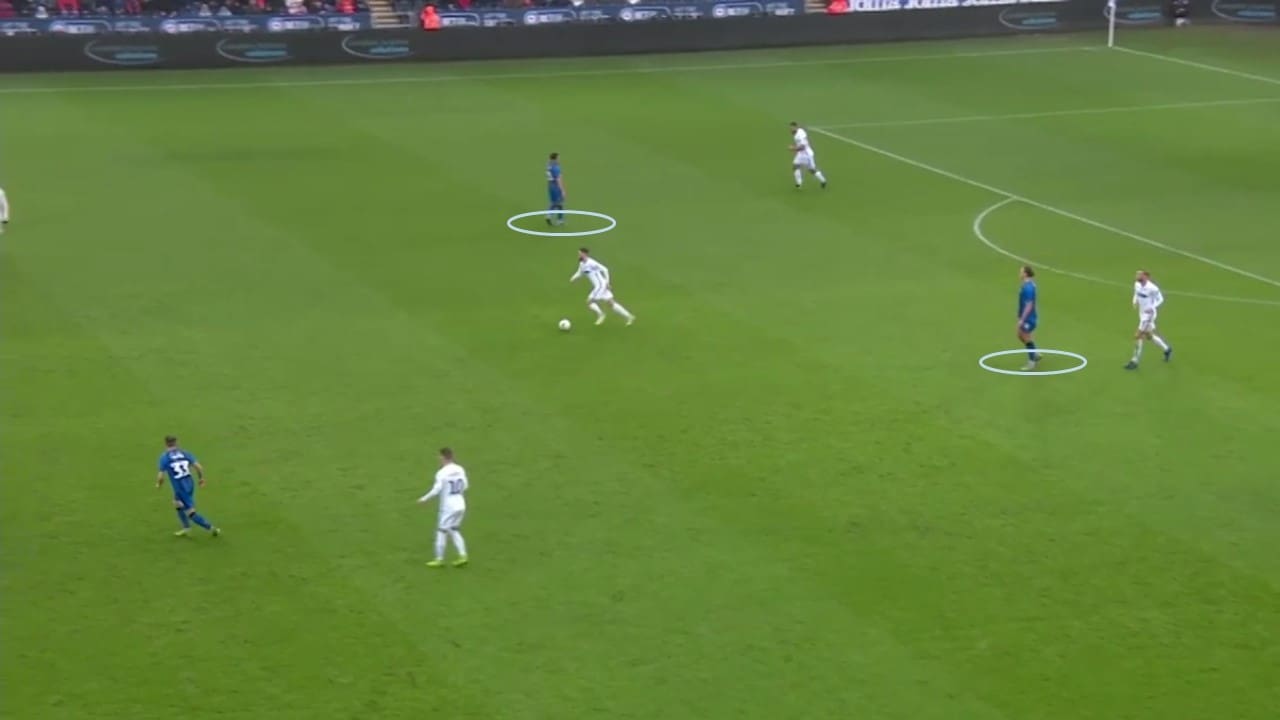
In an effort to stop getting caught out through the middle, Gillingham ditched their 3-5-2 system in favour of a 4-5-1 in the latter stages of the first-half.
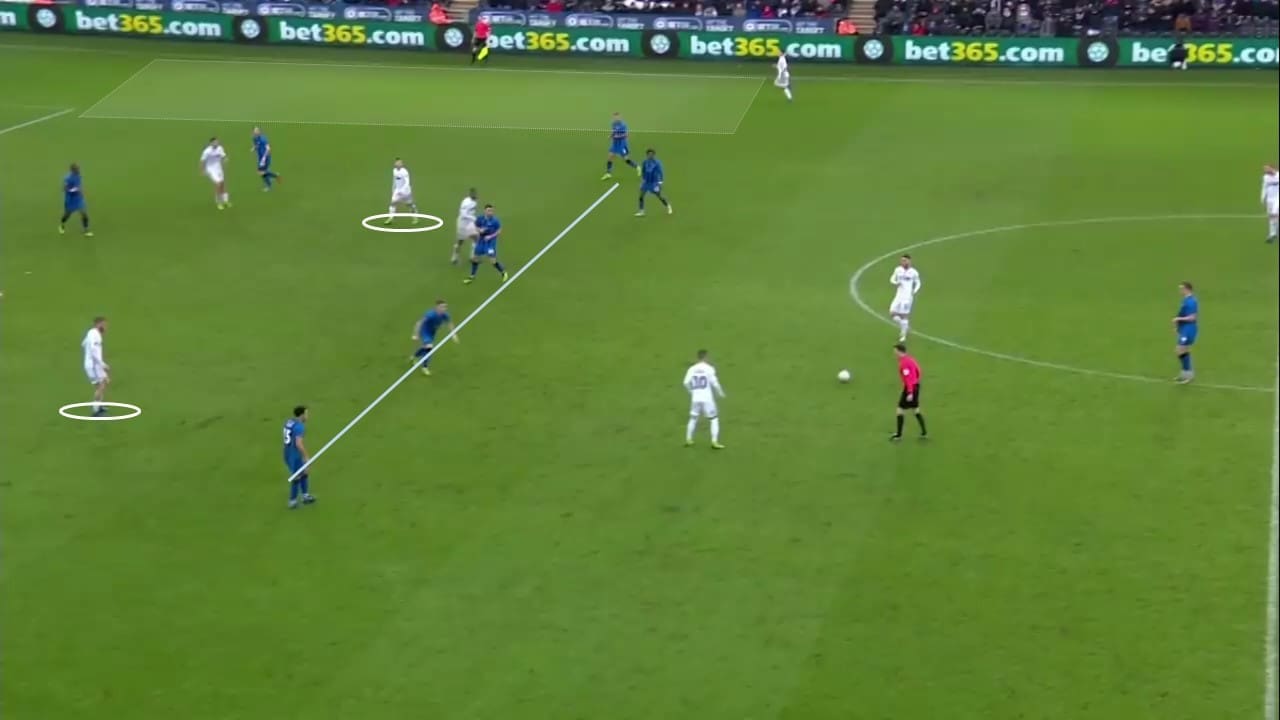
They also dropped further back and looked to get five across the midfield to limit the gaps through the channels. This helped to ensure that 2-0 didn’t become 3-0 before half-time. Below, McBurnie has less space to work with and can’t turn and make forward runs towards the final third.
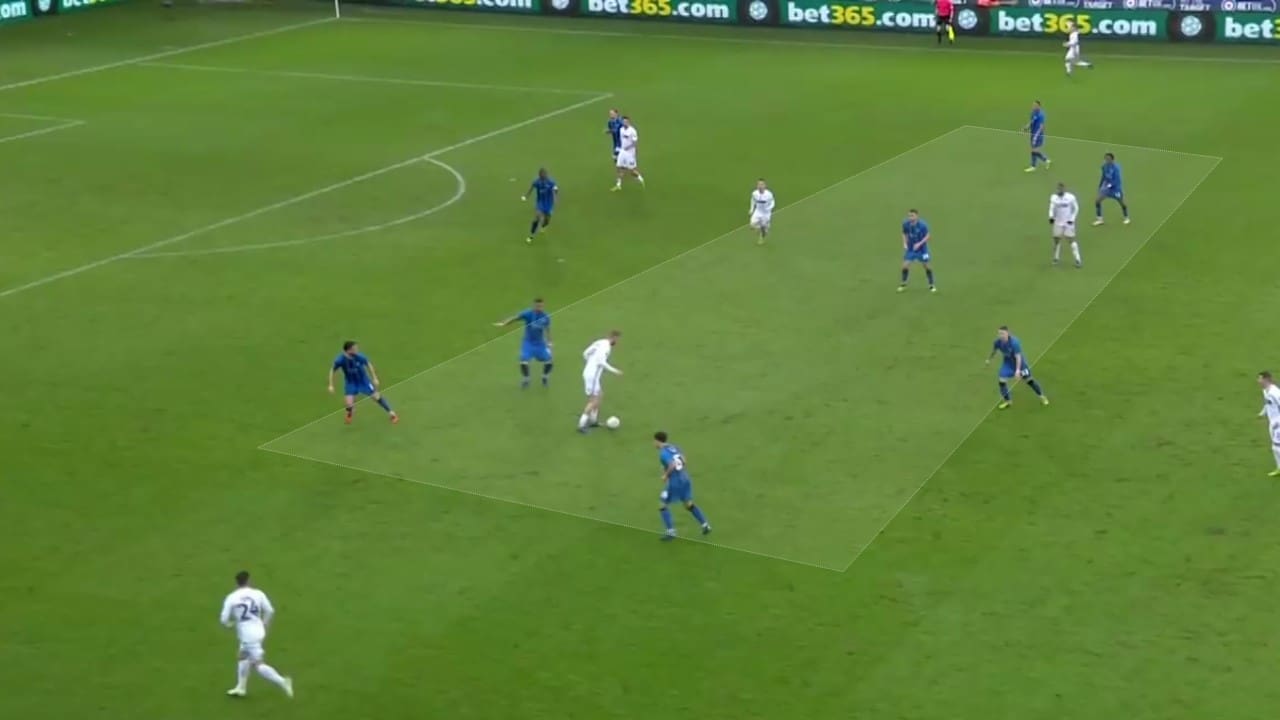
As Gillingham drop back, allowing Grimes to bring the ball out, he no longer has multiple passing options in front of him. There isn’t a clear passing route through for McKay inside the centre circle, and McBurnie is also covered alongside him.
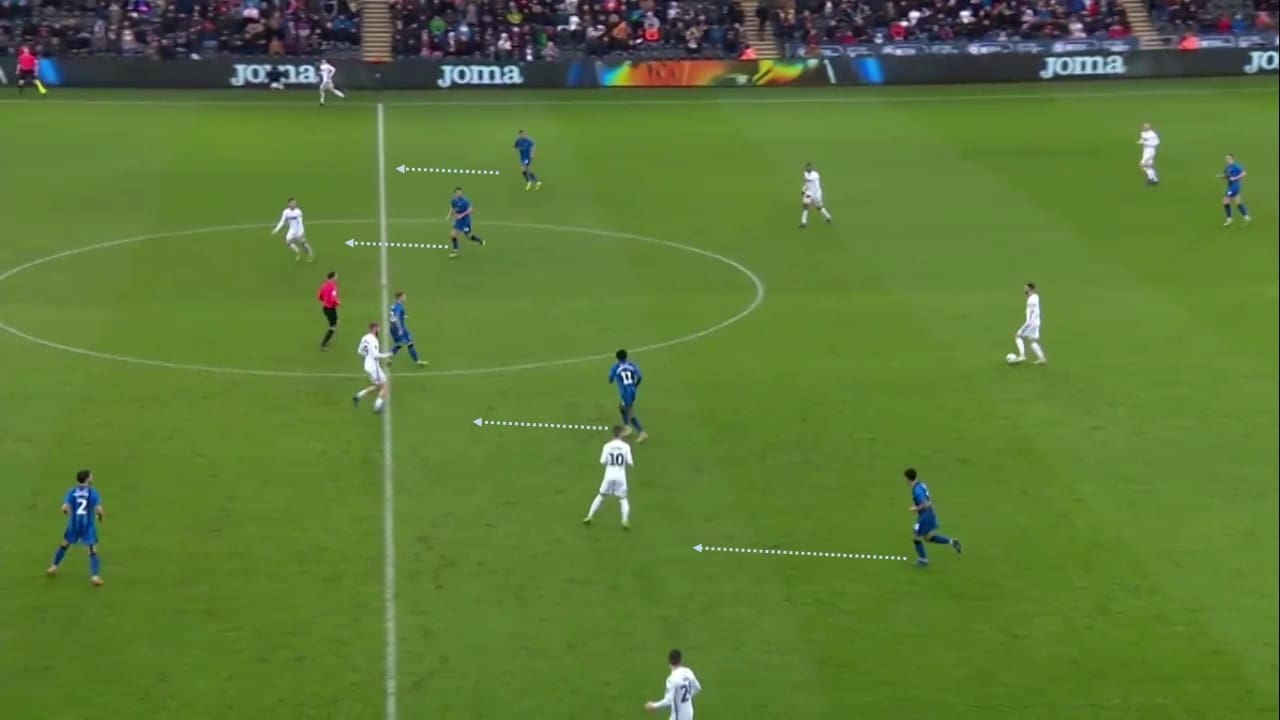
Gillingham were barely able to get forward in the first half such was Swansea’s dominance and control. When they did, it was always after playing long and direct balls to chase down the flanks.
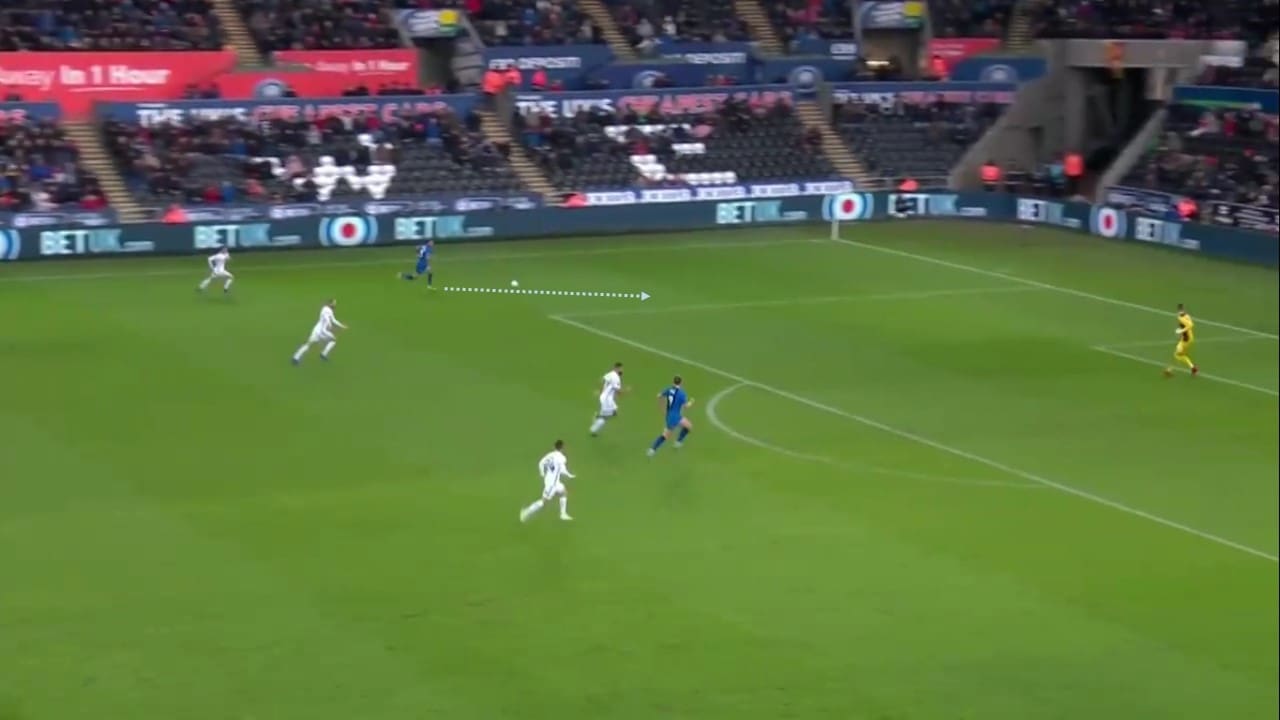
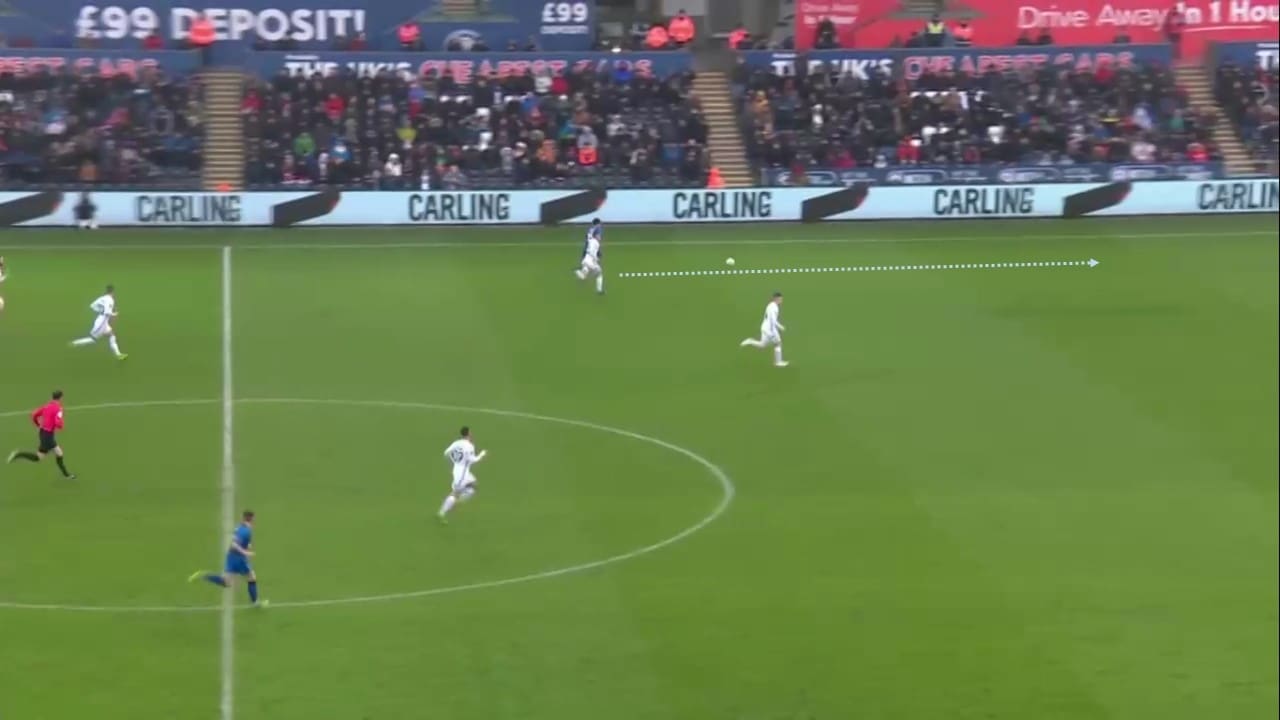
Too often they attempted to play patient passing football when regaining possession in their own defensive third. Against a forward-committed Swansea side however they needed to play quick long balls forward on the counter-attack.
There was a passage of play lasting around 30 seconds during the 27th minute that perfectly summed this up. The below screenshot shows the start of it. Gillingham have regained possession but they miss an opportunity to hit Swansea on the counter-attack.
There’s a free player in space in the shaded area that the player about to receive the ball could pass to. Alternatively there’s the option to hit a ball over to the far side for a player to chase in behind Swansea’s midfield duo.
Instead, Gillingham played passes across their backline and took around 30 seconds to finally break into Swansea’s half before losing possession in a wide right area. When doing so, Swansea could play a simple pass forward and they were back on the attack.
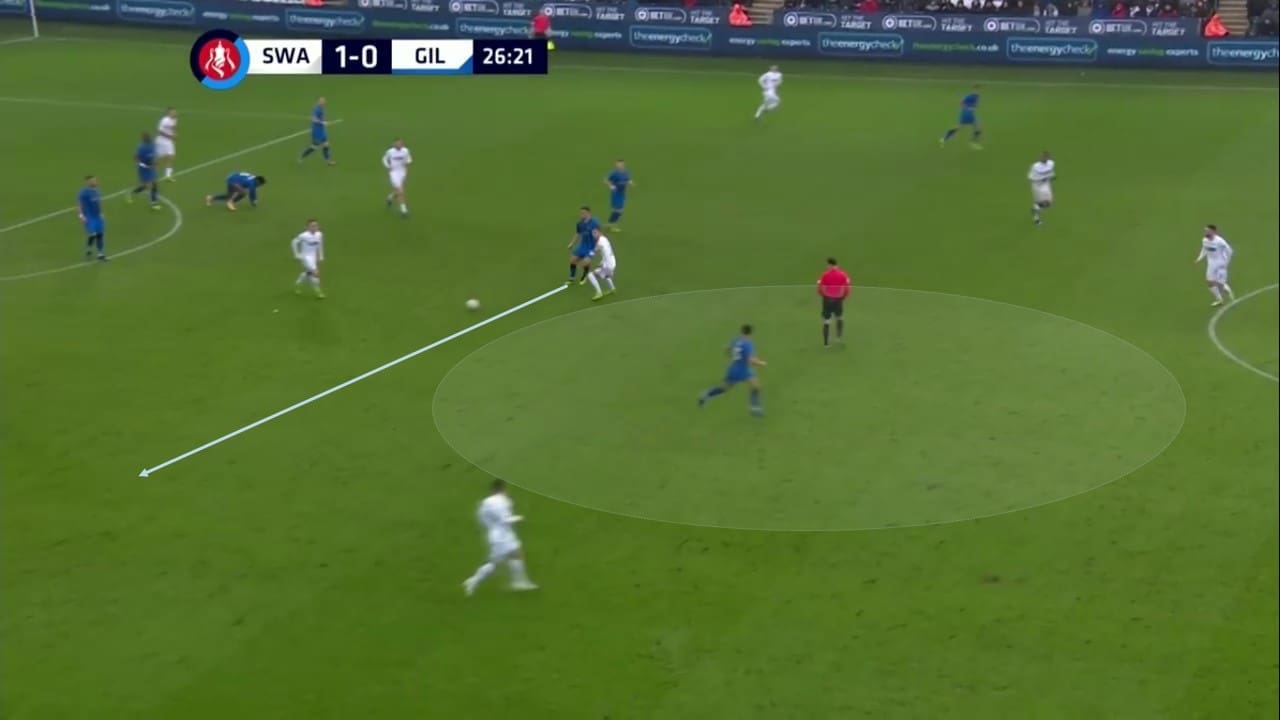
Gillingham changed their approach in the second half and they got their rewards, getting a goal back within just six minutes of the restart. It wasn’t only their shape and tactics that needed changing, but their energy levels too. There was a clear improvement in this department after the break.
It looked as though Gills manager Lovell wanted his side to increase their intensity and energy levels and look to play the ball more quickly and directly into wide areas.
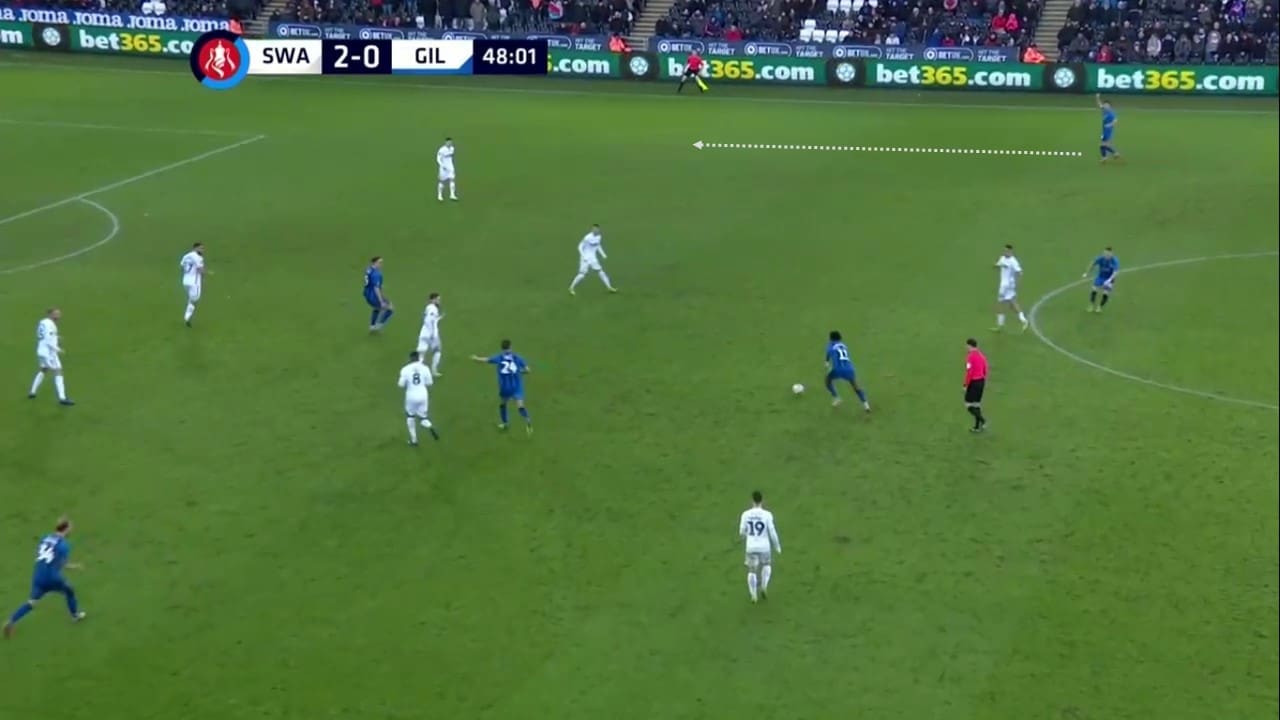
Gillingham make a faster start to the second half and they have the option to release a player down the right flank
Gillingham get a goal back
After the ball is stolen from McBurnie just inside their own half, the visitors waste no time in playing the ball forward for Elliot List to run forward through the right half-space.
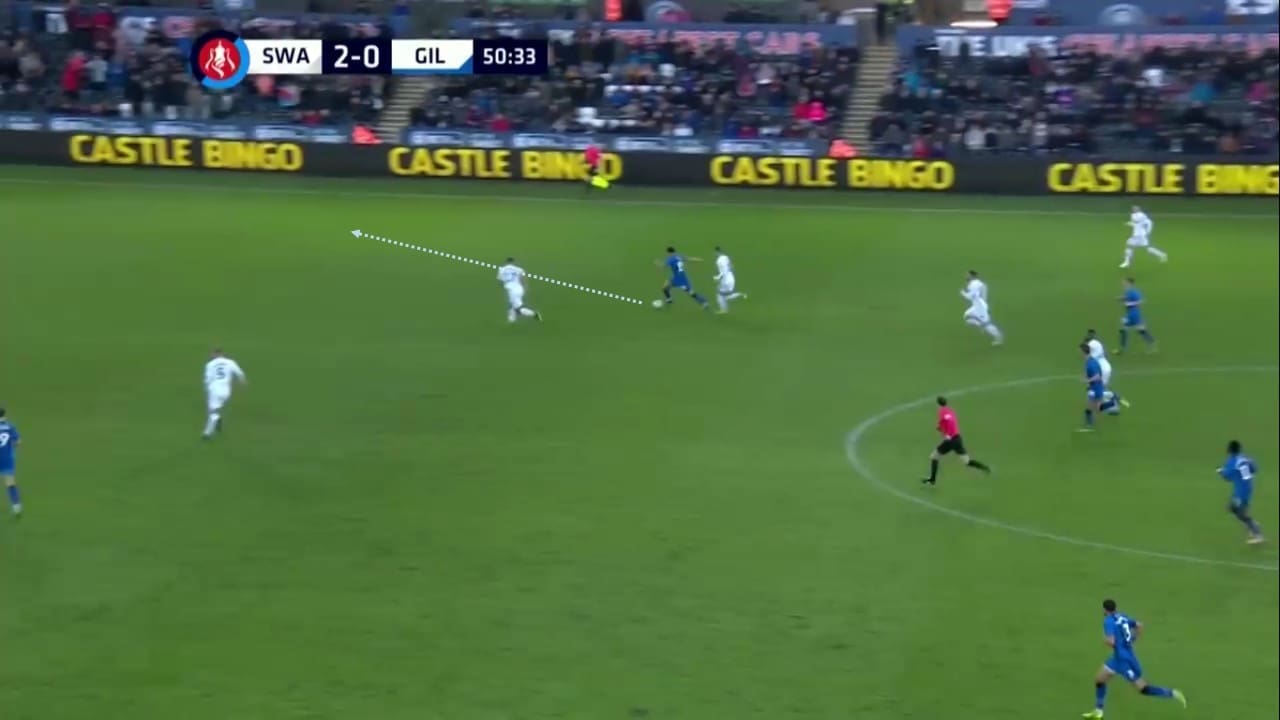
Carter-Vickers appears to have marshalled him out towards the right touchline but he doesn’t do enough to limit the threat. List is able to turn back to feed a team-mate who’s unmarked in the half-space. The cross comes in and similar to McBurnie’s opener, Josh Rees can get in between two defenders to head home with relative ease.
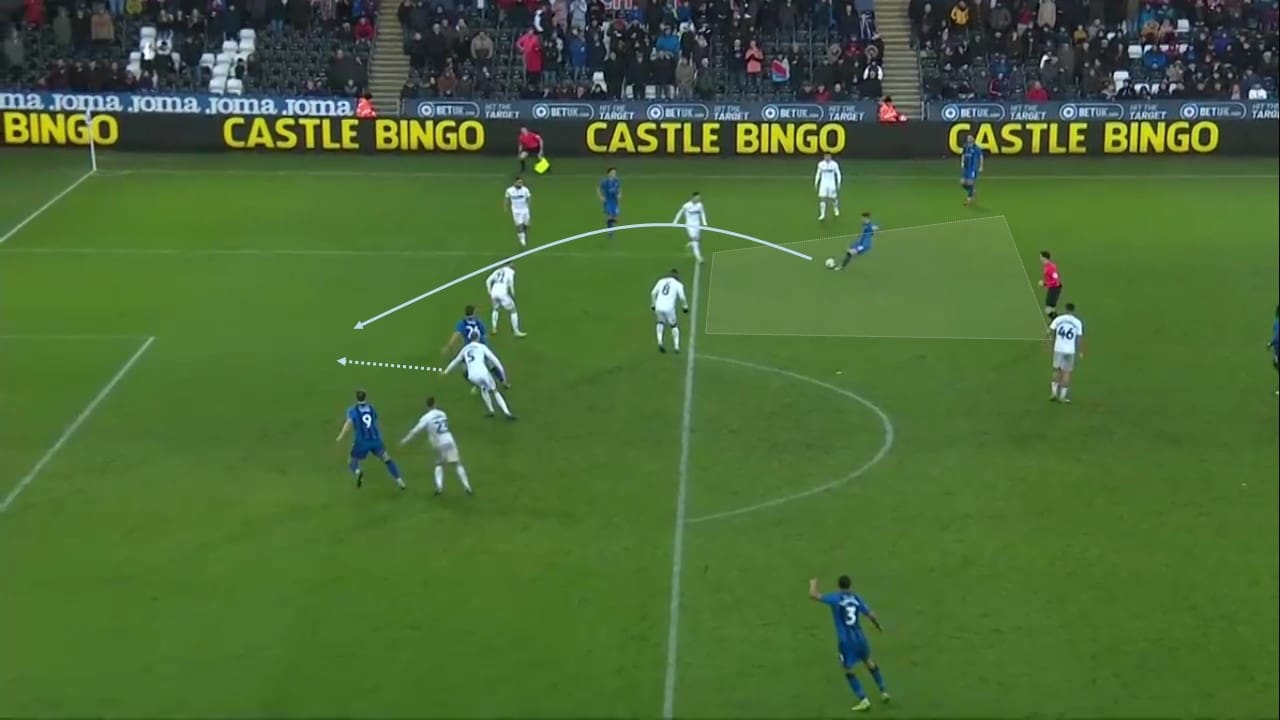
Gillingham continued to play more direct football, often looking to get balls quickly into wide areas for crossing opportunities.
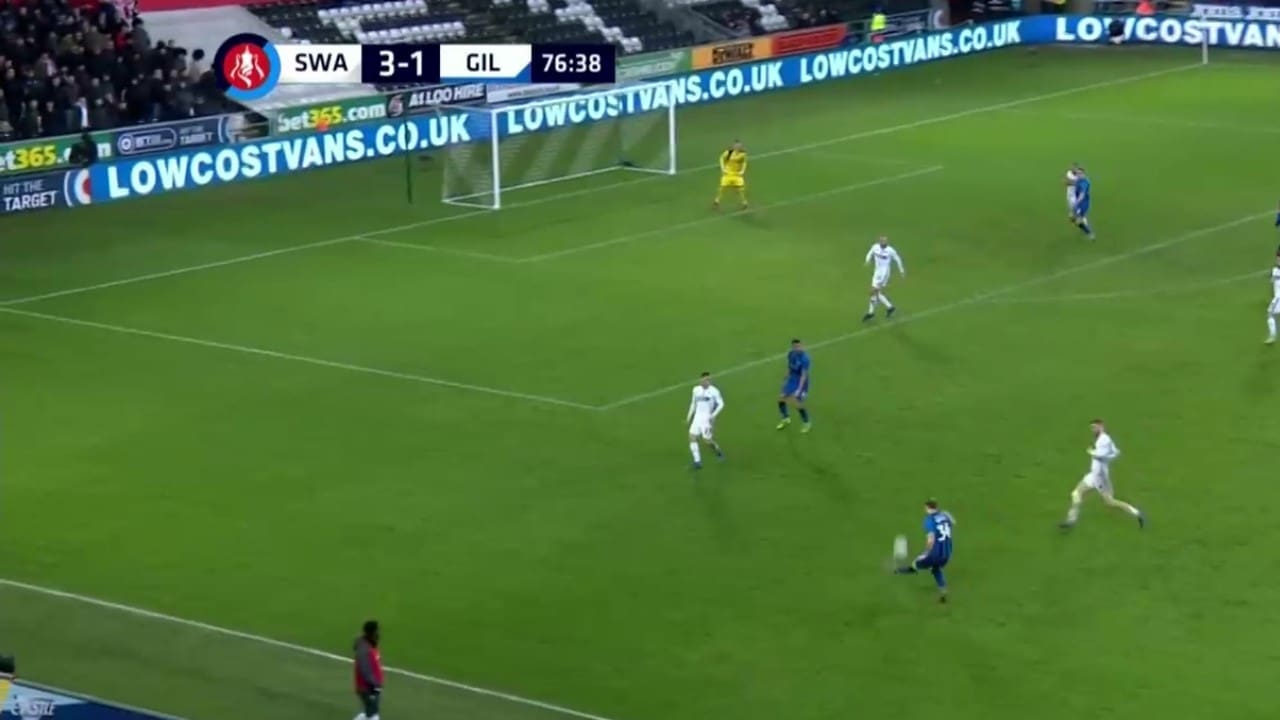
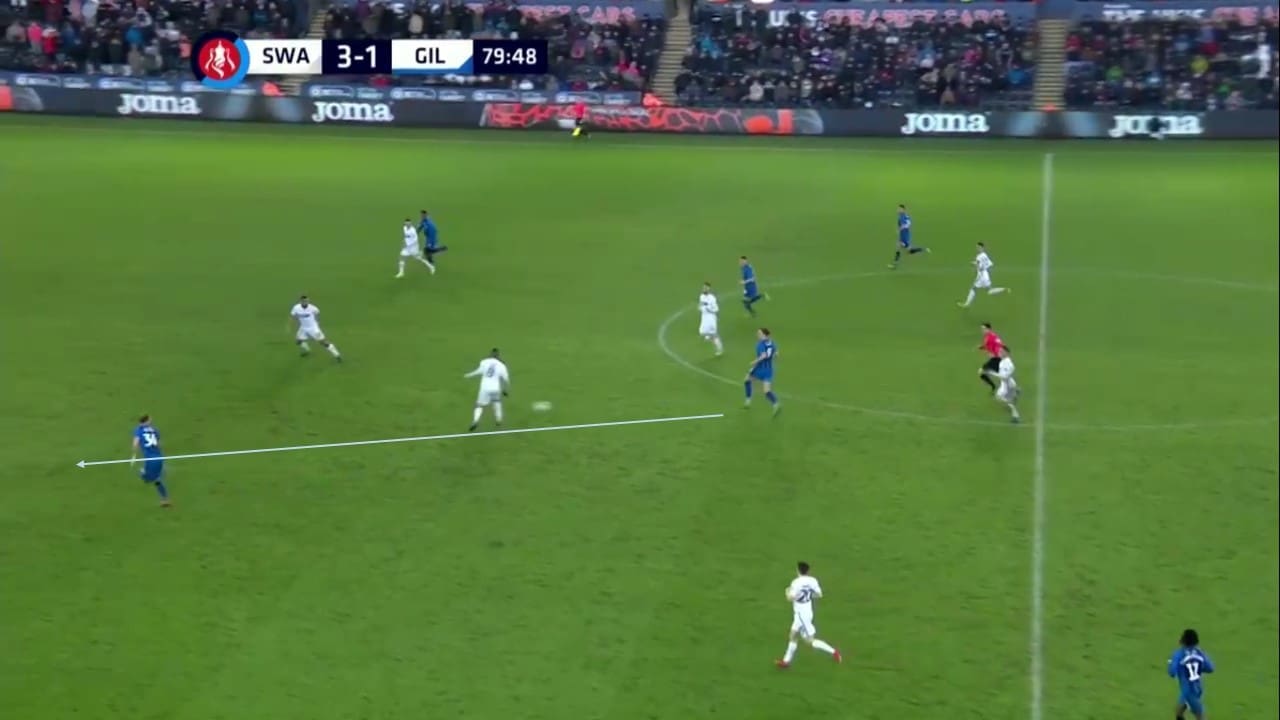
Celina’s wonder goal ends Gillingham’s hope
With the score at 2-1 and Swansea City previously cruising, Gillingham suddenly had some hope as they managed to keep things relatively tight for the next 25 minutes. From Swansea’s point of view, they should have been out of sight at half time, but they easily allowed Gillingham back into the game with their first real chance to make it 2-1.
However, Gillingham would have been disappointed to allow Swansea to restore their 2-goal cushion after somewhat easing the onslaught of pressure. It was an incredible 30-yard strike from Bersant Celina but from a defensive point of view, he should’ve been closed down to prevent the shooting opportunity.
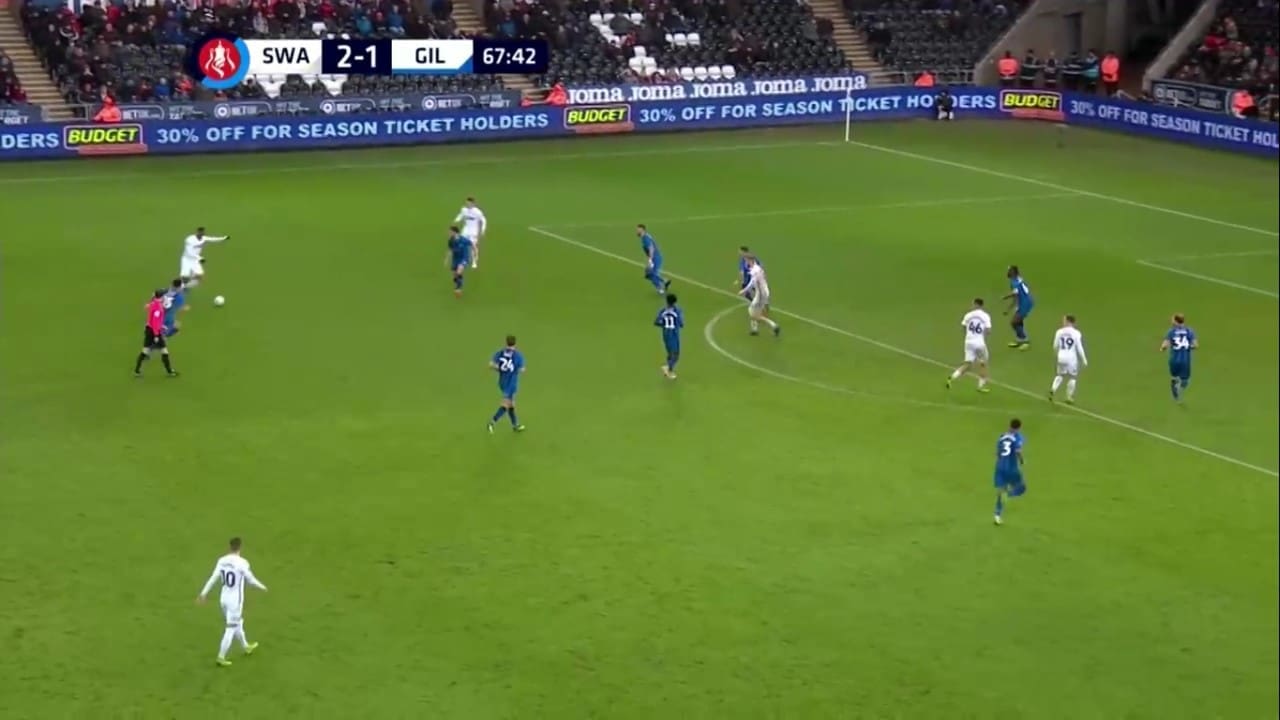
Before Celina’s strike, both Leroy Fer and Matt Grimes were allowed attempts on goal from similar positions. Fer mishit his effort but Grimes managed to force a decent save from the goalkeeper.
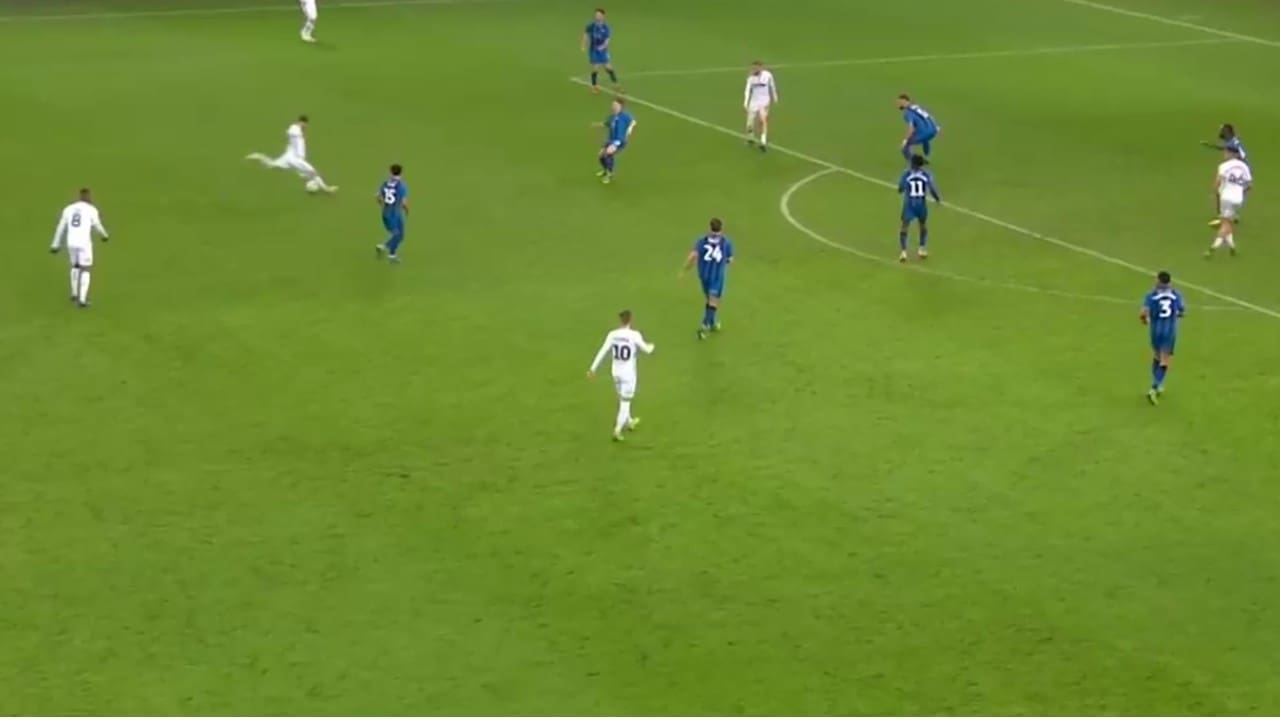
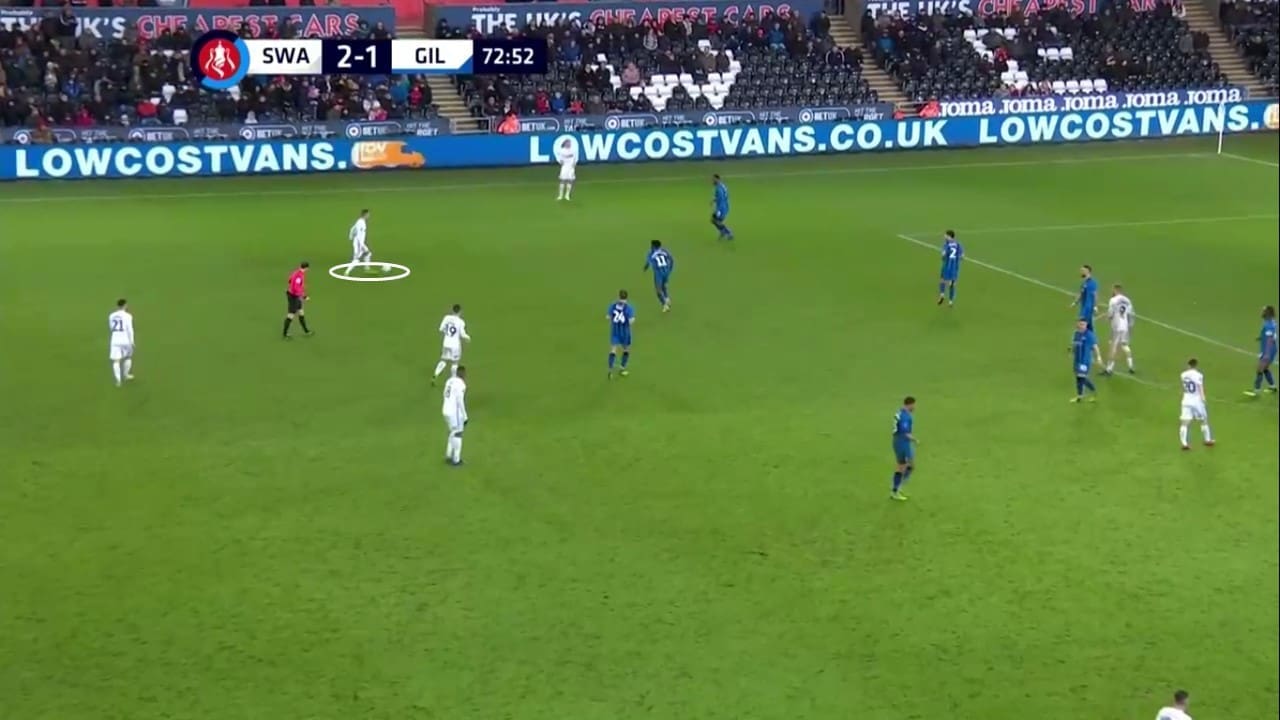
There was no stopping Celina’s effort however as it arrowed straight into the top corner.
Swansea add a fourth
Swansea City didn’t want to rest on their 3-1 lead and brought on Leeds United target Dan James in the 69th minute, four minutes before Celina’s goal. Like it had against Sheffield United the previous weekend, the flying winger’s pace caused Gillingham all sorts of problems down the right flank.
His raw speed meant that the Swans could simply play a ball down the right and it was likely that James would get on the end of it and get into a promising attacking position. As well as chasing balls, James was also able to touch balls past his opposing full-backs and race onto them in space.
On one occasion, he was able to provide fellow substitute Jay Fulton with a scoring position but his headed effort was saved by the feet of Tomas Holy.
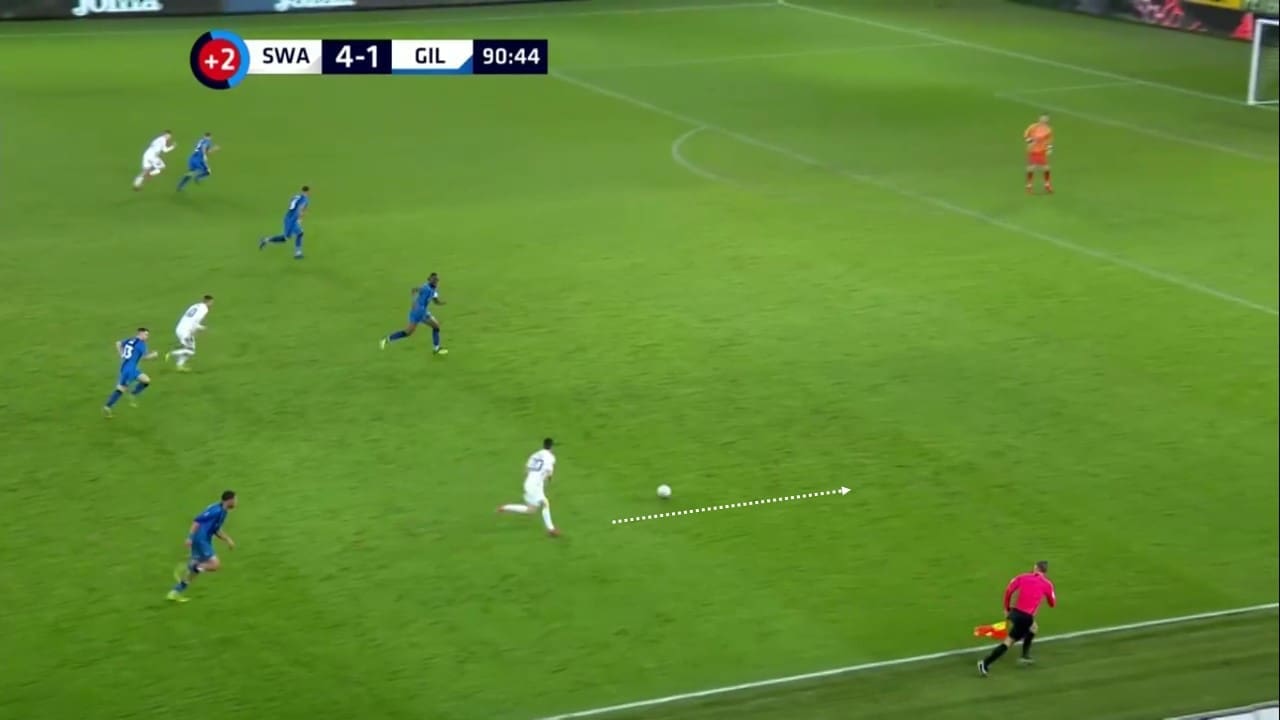
Swansea’s fourth goal came from another quick move that started with James in his own half playing a ball ahead to Celina. Celina then quickly plays a ball ahead to George Byers who plays a first-time pass for James to chase. He gets to the byline, pulls the ball across and McKay is waiting just a few yards out to touch the ball into the net.

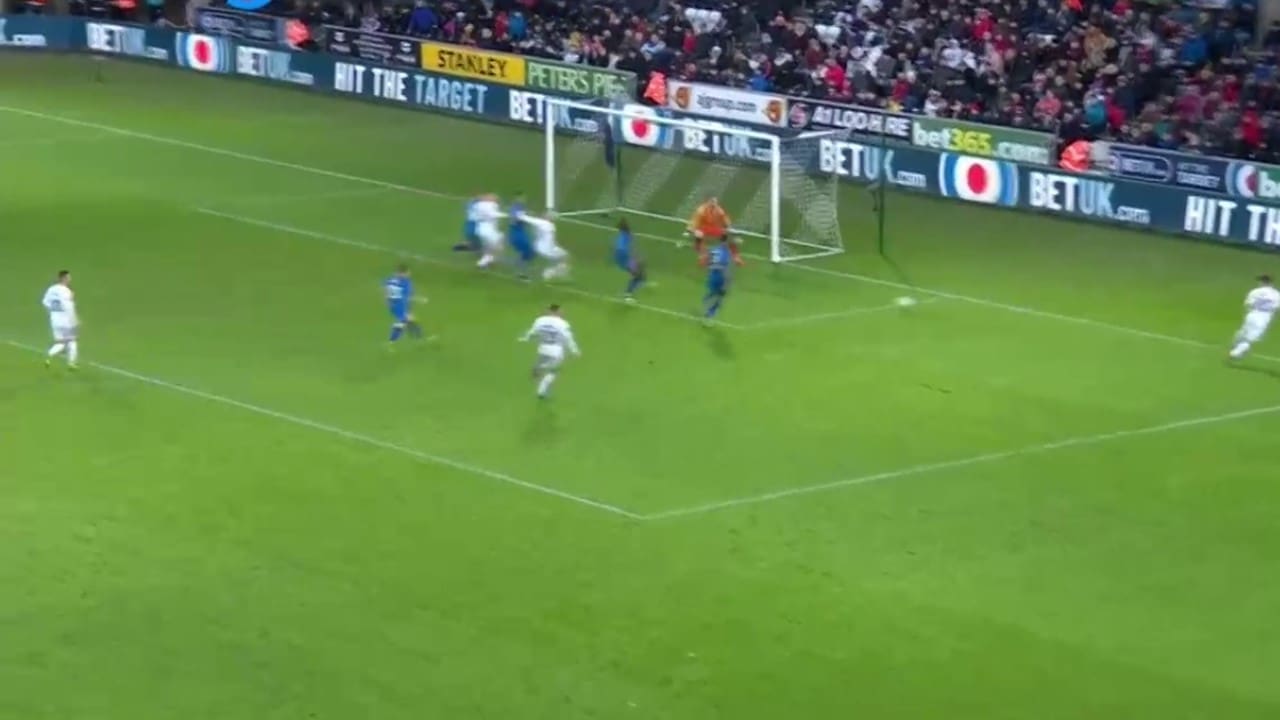
Conclusion
It was another convincing and impressive performance from Swansea City who are enjoying some good momentum in 2019. They were another level above Gillingham and at times they could and should have done more with the positions they found themselves in inside the final third.
A soft goal gave Gillingham hope. The visiting side fixed their problems in the first half and played more to their strengths, but Swansea’s quick movement and direct passing play just proved to be too much too handle in dominant spells in the first half an hour and the final 20 minutes.
If you love tactical analysis, then you’ll love the digital magazines from totalfootballanalysis.com – a guaranteed 100+ pages of pure tactical analysis covering topics from the Premier League, Serie A, La Liga, Bundesliga and many, many more. Buy your copy of the January issue for just ₤4.99 here, or even better sign up for a ₤50 annual membership (12 monthly issues plus the annual review) right here.

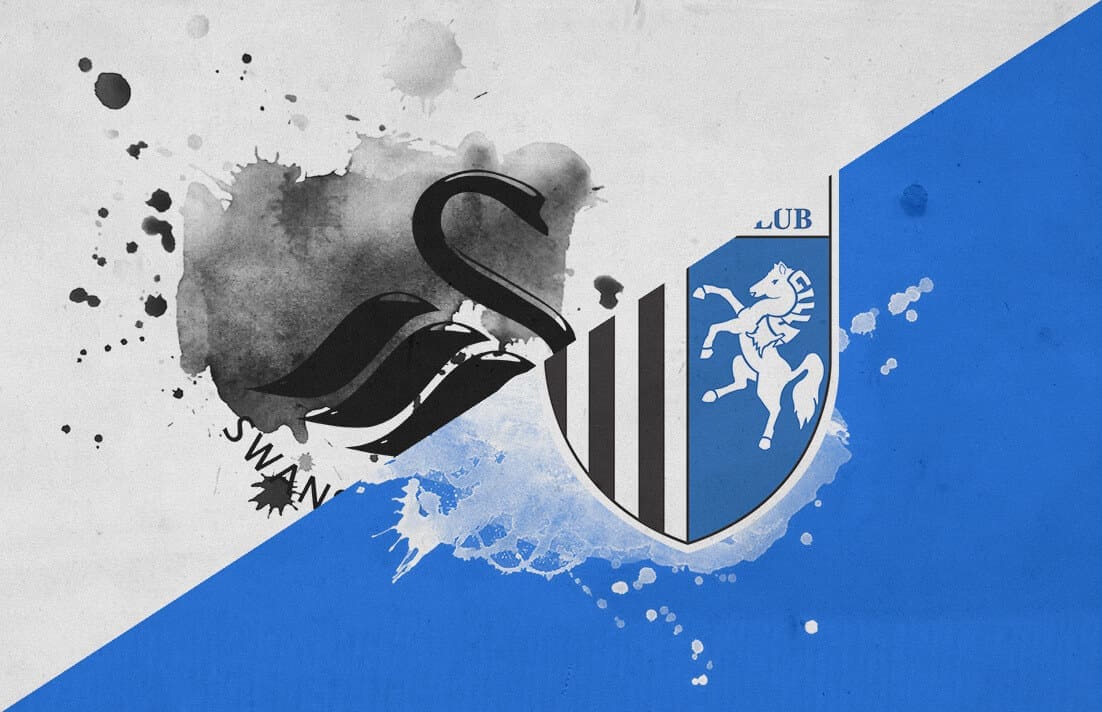




Comments